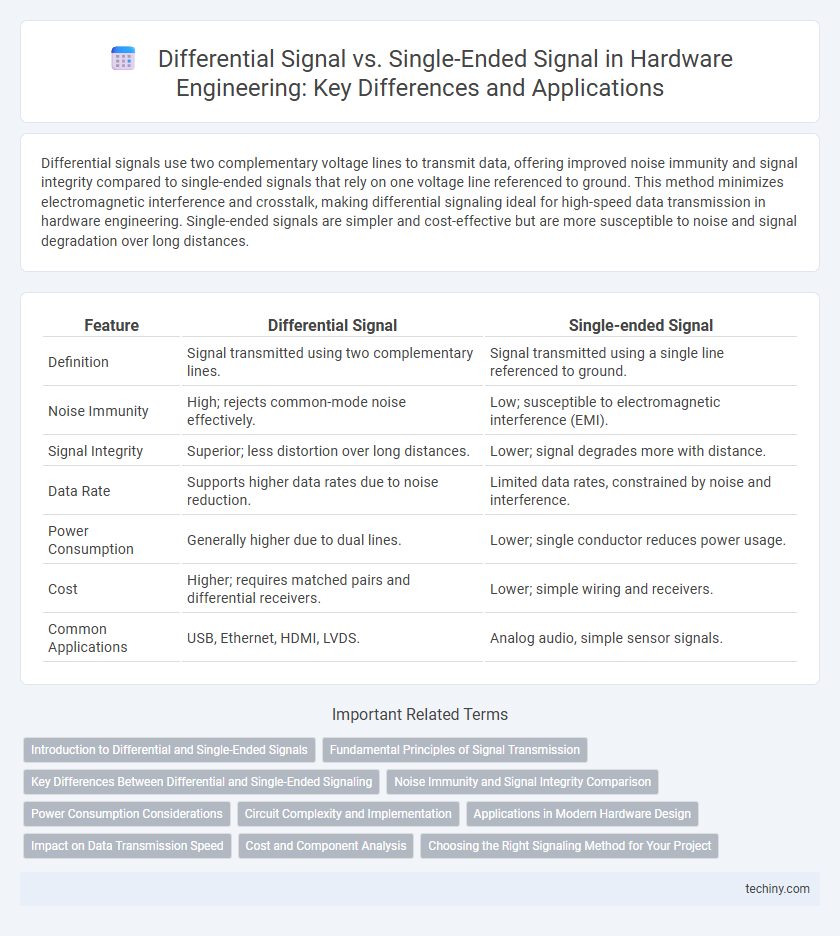Differential signals use two complementary voltage lines to transmit data, offering improved noise immunity and signal integrity compared to single-ended signals that rely on one voltage line referenced to ground. This method minimizes electromagnetic interference and crosstalk, making differential signaling ideal for high-speed data transmission in hardware engineering. Single-ended signals are simpler and cost-effective but are more susceptible to noise and signal degradation over long distances.
Table of Comparison
| Feature | Differential Signal | Single-ended Signal |
|---|---|---|
| Definition | Signal transmitted using two complementary lines. | Signal transmitted using a single line referenced to ground. |
| Noise Immunity | High; rejects common-mode noise effectively. | Low; susceptible to electromagnetic interference (EMI). |
| Signal Integrity | Superior; less distortion over long distances. | Lower; signal degrades more with distance. |
| Data Rate | Supports higher data rates due to noise reduction. | Limited data rates, constrained by noise and interference. |
| Power Consumption | Generally higher due to dual lines. | Lower; single conductor reduces power usage. |
| Cost | Higher; requires matched pairs and differential receivers. | Lower; simple wiring and receivers. |
| Common Applications | USB, Ethernet, HDMI, LVDS. | Analog audio, simple sensor signals. |
Introduction to Differential and Single-Ended Signals
Differential signals transmit data using two complementary voltage lines, enhancing noise immunity and signal integrity compared to single-ended signals, which use a single voltage line referenced to ground. In hardware engineering, differential signaling reduces electromagnetic interference (EMI) and crosstalk, making it essential for high-speed data communication like USB, Ethernet, and HDMI. Single-ended signaling remains common in low-speed, cost-sensitive applications where simplicity and ease of implementation are prioritized.
Fundamental Principles of Signal Transmission
Differential signals transmit data using two complementary voltage lines, significantly reducing electromagnetic interference and crosstalk compared to single-ended signals that rely on a single voltage reference and ground. This fundamental principle enables improved noise immunity and signal integrity by utilizing the voltage difference between paired conductors rather than the absolute voltage against ground. Differential signaling is essential in high-speed hardware engineering applications to maintain reliable and accurate data transmission across complex electronic systems.
Key Differences Between Differential and Single-Ended Signaling
Differential signaling transmits two complementary signals over a pair of wires, enhancing noise immunity and reducing electromagnetic interference (EMI), while single-ended signaling uses one wire referenced to ground, making it more susceptible to noise and signal degradation. Differential signals typically offer higher data integrity and are preferred in high-speed and long-distance communication, whereas single-ended signals are simpler and cost-effective for short-distance, low-speed applications. Key differences include improved common-mode noise rejection in differential signaling and simpler circuit design in single-ended signaling.
Noise Immunity and Signal Integrity Comparison
Differential signals exhibit superior noise immunity compared to single-ended signals due to their ability to reject common-mode noise through balanced transmission lines, enhancing signal integrity in high-speed hardware designs. Single-ended signals are more susceptible to electromagnetic interference and signal degradation over long distances or in noisy environments, potentially causing data errors. Consequently, differential signaling is preferred in modern hardware engineering for maintaining robust, high-fidelity communications across circuit boards and connectors.
Power Consumption Considerations
Differential signals consume more power than single-ended signals due to the constant current flow in both lines, which improves noise immunity but increases energy usage. Single-ended signals use a single conductor and ground reference, resulting in lower power consumption but higher susceptibility to noise and signal degradation. Choosing between the two involves balancing power efficiency with signal integrity requirements in hardware design.
Circuit Complexity and Implementation
Differential signal circuits generally require more complex hardware due to the need for paired traces and differential amplifiers, increasing board space and design effort. Single-ended signal circuits are simpler to implement with fewer components and straightforward routing, reducing overall circuit complexity. However, differential signaling offers improved noise immunity and signal integrity, which often justifies the additional design complexity in high-speed or noisy environments.
Applications in Modern Hardware Design
Differential signals are widely used in high-speed communication interfaces such as USB, PCIe, and Ethernet due to their superior noise immunity and reduced electromagnetic interference compared to single-ended signals. Single-ended signals remain common in simpler, low-frequency circuits like microcontroller I/O and basic sensor interfaces where cost and complexity are minimal concerns. Modern hardware design leverages differential signaling for improved signal integrity and performance in densely packed, high-speed environments.
Impact on Data Transmission Speed
Differential signaling enhances data transmission speed by reducing electromagnetic interference (EMI) and crosstalk compared to single-ended signals, allowing higher frequency signals to propagate with greater integrity. Differential pairs maintain signal quality over longer distances and at faster rates due to improved noise immunity and balanced transmission lines. Consequently, hardware engineers prefer differential signaling in high-speed applications such as PCIe, USB 3.0, and Ethernet to achieve reliable and faster data transfer.
Cost and Component Analysis
Differential signaling requires a pair of conductors and typically involves more complex transceiver circuits, leading to higher initial hardware costs compared to single-ended signaling which uses a single conductor and simpler components. The increased component count and need for precise matching in differential pairs can raise PCB manufacturing expenses but offers improved noise immunity and signal integrity, reducing potential system failures and maintenance costs over time. Cost-benefit analysis must consider the trade-off between premium components and the enhanced performance differential signaling provides in high-speed, noise-sensitive applications.
Choosing the Right Signaling Method for Your Project
Differential signaling offers superior noise immunity and signal integrity compared to single-ended signaling, making it ideal for high-speed and long-distance hardware communication. Single-ended signaling, while simpler and cost-effective, is more susceptible to electromagnetic interference and noise, which can degrade signal quality in complex environments. Evaluating factors such as signal speed, distance, and electromagnetic conditions is crucial for selecting the appropriate signaling method in hardware designs.
Differential signal vs Single-ended signal Infographic

 techiny.com
techiny.com